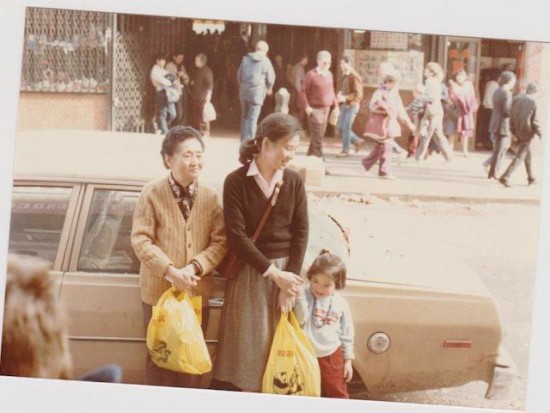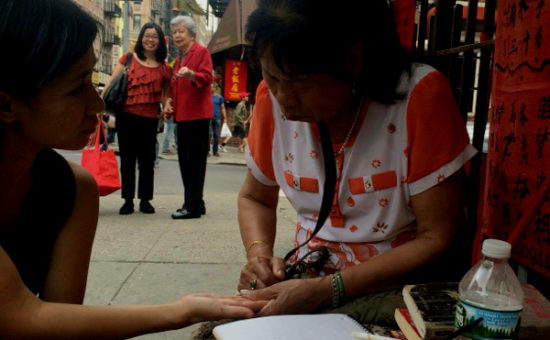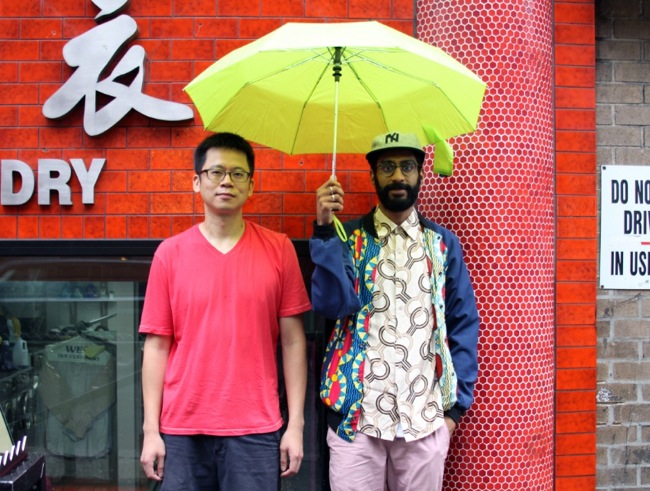How do Chinatown leaders work towards community preservation in the Year of the Earth Dog?
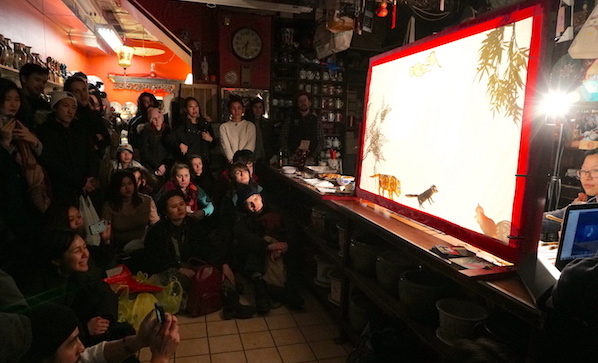
March 29, 2018
Diane Wong beams a wide grin when the tiny fox announces in a booming voice that he has learned to borrow a tiger’s shadow. Under the glow of light from the shadow puppetry stage resting on the countertop of Wing on Wo & Co. (W.O.W.), she remembers this Chinese folk tale Hu Jia Hu Wei 狐假虎威 from Chinese school years ago. In it, a fox tricks a tiger to walk behind him through the forest so the other animals scamper out, afraid. Unknowingly lending his shadow to the fox, the tiger begins to believe the fox is the true ruler of the forest.
The stage lights dim. Applause resounds off the teapots and teacups sitting on the wooden shelves. Wong, an ethnographer who studies the gentrification of Chinatowns, stands with others in the shop who, like her, are there to celebrate W.O.W.’s Storefront Residency’s opening exhibition focused on the theme of sweeping away evil and building community in the year of the earth dog in the face of rapid gentrification in Chinatown.
W.O.W. owner Mei Lum has transformed the century-old, family-run porcelain shop into a community event space dedicated to promoting the arts for social change by nightfall.
In the storefront display, miniature porcelain dogs with broomsticks sweep away evil as they watch the paper-cut shadow puppetry recordings that artist-in-residence Emily Mock compiled from her community paper-cutting workshops to highlight the building of home and safety in the Lunar New Year. Together, these events and artworks are public programs that carry out the mission of The W.O.W. Project: to reclaim Chinatown’s future through the cultivation of the creative arts, culture, and activism.
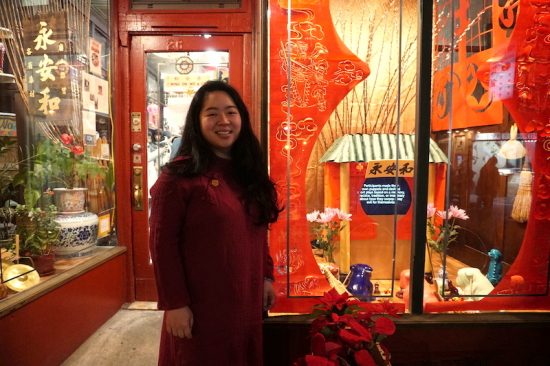
Wing on Wo & Co., the oldest family-run business in Chinatown, dates back to the 1890s. On the brink of losing the store in 2015, fifth-generation Chinese American Mei Lum stepped in to take over the business and infused it with an entrepreneurial inclusion of arts and activism. One initiative is an annual, six-month 店面 Storefront Residency to create a storefront display for Lunar New Year. This year, Mock, an artist and educator working at The Laundromat Project, centered her residency on the thematic question of “what do you do to sweep away evil?”
“I didn’t know that you’re supposed to sweep or clean your house before the actual first day of Chinese New Year as a way to sweep away evil and open up space to good will and good luck,” Mock said. “I didn’t know that growing up.”
The thematic question was, thus, a cultural exploration of what is practiced in Chinese communities to create safety and home for the New Year, and also a symbolic one about efforts to tackle the evils of urban displacement in Chinatown. After learning paper-cutting and creating their own figures, workshop participants created shadow puppet stories around this theme. “My big goal in doing this residency is to provide time, space, and resources for people in the diaspora, who come from a tradition of paper-cutting and shadow puppetry, to feel like we have access to that,” Mock, whose workshops have reached almost 100 participants, said.
In late January, Mock hosted and moderated a panel with artist-activists that discussed what it means for them to sweep away evil through their local work and projects. Chinese medicine practitioner Donna Mah, The Laundromat Project artist Fay Bonas, stand-up comic Jes Tom, Chinatown Tenants Union organizer Melanie Wang, and Spiderwoman Theater founder Muriel Miguel spent the night sharing rituals, practices, and ideas that contributed to the preservation of self and community in a changing New York City.
The intergenerational gathering of local residents, speakers from communities of color across the city, and community members drawn to W.O.W. because of their own roots in Chinatown was in itself an embodiment of the night’s theme.

Events such as this panel are timely, as communities of color across New York City face rapid gentrification through evictions, landlord harassment, rising rents, and increased luxury development. In Chinatown in late January, landlord Joseph Betesh displaced over 85 longtime residents, including children and elderly tenants, from their homes on 85 Bowery Street. Days before the Lunar New Year in mid-February, tenants went on a hunger strike to pressure Betesh make quicker repairs to a staircase deemed unsafe to be able to return home. Although that repair has since been made, tenants are still homeless two months later because other building issues have been discovered. This one case is a microcosm of the larger issue of displacement that is rampant in Chinatown. Since 2002, over 15,000 units of rent-regulated apartments in the neighborhood have been lost.
Of all racial groups, only the White population has grown in Chinatown in the last decade, a 2013 study found, while the number of Chinese American residents decreased by almost 20 percent in that same time period.
Yet, these changes never happen without an ongoing fight. Wang of the Chinatown Tenants Union shared her work building the collective power of Chinatown residents. She has been involved with coalitions across the city to reform Major Capital Investment rent increases, which are permanent rent increases for rent-stabilized tenants based on the money a landlord spends on building-wide renovations. In some cases, landlords have used renovations as an excuse to raise rents towards deregulating a building. CAAAV has also been working to pass a rezoning of the waterfront in the Two Bridges area of Chinatown, to limit the development of skyscrapers, which does not address residents’ need for more affordable housing.
“Sweeping away evil is one half of the story. It is to prepare for blessings. It is to prepare for abundance.”
Bonas of The Laundromat Project drew parallels between her work in The Bronx and that of Wang’s. “We’re really trying to build a new legacy,” she said. Her work with The Laundromat Project focuses on community renewal and preservation through the arts. In The Bronx, a study by the Regional Plan Association found that residents are at the highest risk of being pushed out due to gentrification— with 56 percent of households spending more than 30 percent of their household income on rent that has been rising exponentially over the years.
Bonas narrated the history of art projects in the midst of economic struggle in The South Bronx, including The Scarecrow Project, which taught children the importance of community stewardship through caring for a community garden on Kelly Street and creatively bringing to life scarecrows to protect it.
Both Tom and Miguel drew on this legacy-building from their personal lives. Tom, the stand-up comic, has been invested in finding a way to balance remembering the history of activism in their family while also molding their own path as a comic and actor who succeeds without compromising their commitment to the queer and trans Asian American community.
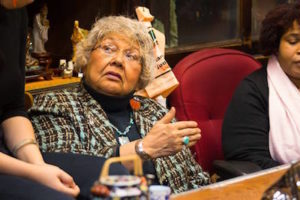
Miguel, of Spiderwoman Theater, delved deeper into what it means to not only sweep away evil, but to also prioritize the act of remembering. She uses her theater work to address gender violence against Native American women and emphasized the importance of ancestral cleansing rituals, such as burning sage and sweet grass to purify and bring in positive, healing energy. “We pray with it and put it on us. So we don’t sweep away, but we remember this way,” she said.
From cooking family recipes, intentionally breathing, and lighting a candle to sharing food during tenant organizing meetings, the panelists emphasized the rituals, memories, and practices to create calm in the everyday chaos and greater societal issues. “Self-care in all of these, in terms of cleaning, what we hold onto, what we let go, eating well, having community support, laughing in the face of darkness, is all really important,” Mah said.
Bonas added: “Because if we are always heavy and weighed down, we’re heavy and weighed down. How do we move forward and evolve? Sweeping away evil is one half of the story. It is to prepare for blessings. It is to prepare for abundance.”
From developing community-land trusts as alternative forms of land ownership in the fight against gentrification, to deepening conversations of what it means to preserve a neighborhood on Native American land, the panelists synchronized these ideas of what it means to not only be fighting against societal injustices, but to be building a tight-knit, supportive, and caring community as well.
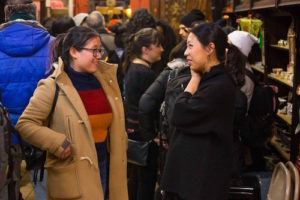
Among the attendees at the panel and storefront display opening were local residents and Chinatown advocates. Bonnie Tse, a resident of the Lower East Side with roots in Chinatown, appreciated the targeted conversations of the events. “Growing up here, I’ve always taken this neighborhood for granted – like things would always be here. But that’s not the case,” she said.
“A lot of mom-and-pop-shops have had to go. And I think the idea about not focusing on evil or what’s lost, but learning how to build and finding what to build for is really inspiring to tune in to,” she added.
Emily He, a student at Barnard College from Vancouver, was drawn to volunteer with W.O.W. for this same urgency of community preservation. Having witnessed and worked to address gentrification in Vancouver’s Chinatown with the Chinatown Action Group (CAG), He said the discussion of what it means to fight for a neighborhood like Chinatown that is first and foremost on Native American land resonated with them.
“It’s also being able to create something new, to envision worlds that may not necessarily exist yet, but to actively move towards that vision.”
“How are we actually actively trying to decolonize the place instead of just paying lip service?” He said. “We use anti-colonial language but we also don’t want to forget the very specific historical events of colonization in terms of the first time in the Americas. Yes, there are colonial relationships in the anti-gentrification work we are doing but it’s not the same.”
He shared examples of CAG’s work translating land acknowledgements into Chinese, and appreciated having the space to explore that seeming contradiction of anti-gentrification work that they have seen.
“I can’t say that spaces like this exist in a way that we feel it right now,” Wong the ethnographer said. Wong helped Lum begin The W.O.W. Project while she was conducting oral histories for her research. She has met residents, business owners, and community organizers across Chinatowns in the U.S.
“A lot of my research is meant to build relationships, to build bridges. For me, that’s what research should be – the process that brings people together in a way that you moving throughout your regular, everyday life, you wouldn’t be able to meet those people,” she said.
“It’s also being able to create something new, to envision worlds that may not necessarily exist yet, but to actively move towards that vision. And that’s what The W.O.W. Project does. It brings different people together in spaces that normally wouldn’t exist. It’s created with the intention of creating conversations that lead to action,” Wong added.

Outside in the storefront, the porcelain dogs continue to watch the shadow puppet plays. Eighty toilet paper rolls painted green fortify the roof of their stage. The entire display is framed in a Chinese gourd laced with Chinese double coins, which often hang in entryways of households and sacred sites as protective objects. Mock also included her grandmother’s broom and backscratchers to add a personal touch to the sanctity of her exhibit. Her art pays homage to cultural traditions and customs, and visually and symbolically evokes the ideas of safety, protection, and community that the panelists and attendees spoke to.
As the crowd inside W.O.W. slowly thinned out and left for home in the brisk winter night, the organizers began returning the porcelain displays back to the center of the store. Among themselves, they spoke of how rejuvenated they felt from the synergy of ideas and warmth of connecting with new and familiar faces that night. Their silhouettes dancing across the storefront merged as they hoped events like these would fortify a community strong enough to resist and outlast challenges that threatened home in this corner of Lower Manhattan.

